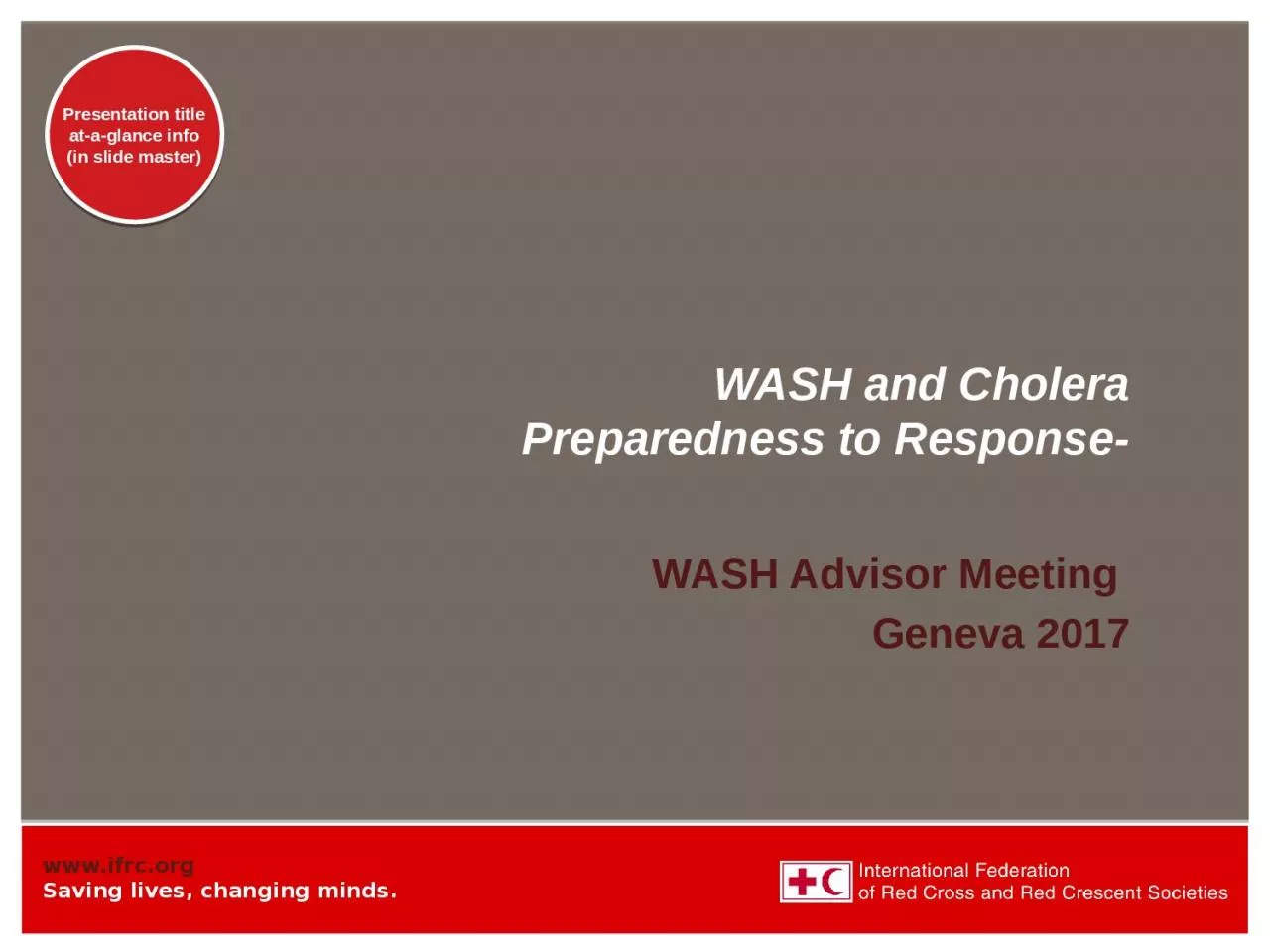

WASH Advisor Meeting Geneva 2017 Global Cholera Burden Updated Global Burden of Cholera in Endemic Counters Ali etl There are an estimated 286 million cases of cholera annually in endemic countries Spatial distribution of the burden of cholera in endemic countries are shown in Count ID: 1037976
Download Presentation The PPT/PDF document "WASH and Cholera Preparedness to Respons..." is the property of its rightful owner. Permission is granted to download and print the materials on this web site for personal, non-commercial use only, and to display it on your personal computer provided you do not modify the materials and that you retain all copyright notices contained in the materials. By downloading content from our website, you accept the terms of this agreement.
1. WASH and CholeraPreparedness to Response- WASH Advisor Meeting Geneva 2017
2. Global Cholera BurdenUpdated Global Burden of Cholera in Endemic Counters Ali etlThere are an estimated 2.86 million cases of cholera annually in endemic countries. Spatial distribution of the burden of cholera in endemic countries are shown in Countries with estimates of more than 100,000 cases annually include: India, Ethiopia, Nigeria, Haiti, the Democratic Republic of the Congo, Tanzania, Kenya, and BangladeshThe average incidence rate in endemic countries is 2.30 cases/1,000 population at risk per yearCholera resulted in approximately 95,000 deaths annually in endemic countries. This translates to approximately 7.50 deaths/100,000 population at risk per year in endemic
3. Trend in cases reported by year and continent 1989 - 2014
4. Countries Reporting Cholera in 2015
5. Worldwide Distribution of Cholera in 2015, by Country*
6. Endemic vs EpidemicNew models suggest cholera dynamics are much more complex than it was previously thoughtMost studies associating cholera dynamics to environmental events are based on correlations. The causal mechanisms behind these correlations are still poorly understood.In some cholera endemic regions, outbreaks are periodic with one or two peaks per year. Seasonal floods and droughts cause periodic variations in contact and contamination rates. If such variations are strong enough to cause large variations of R0, we will note the occurrence of periodic outbreaks. Cholera outbreaks will be triggered when contact and/or contamination rates bring the R0 above the unity thresholdEndemic cholera, however, can be maintained even in the absence of a permanent reservoir.http://bmcinfectdis.biomedcentral.com/articles/10.1186/1471-2334-1-1
7. Cholera in contextFlooding and drought are likely to affect cholera dynamics in a complex way. In endemic regions, cholera outbreaks are often associated to climatic events .In some parts of Africa, outbreaks occur during the dry season or right after heavy rainfalls. In the Americas, disasters caused by the El Niño preceded large cholera outbreaks. In Bangladesh, cholera season coincides with the post-monsoon period. Seasonal variations of water temperature has been also associated to cholera outbreaks.
8. The right response for the right contextMove away from copy paste cholera response:-Prevention, control and ResponseKnow your contextKnow your disease dynamicsEndemic vs epidemicSeasonalityHot spotsTransmission routesDesign for root cause control of transmission
9. Sword and Shield Response – linking with the Epidemiology
10. Approaches to Cholera ControlThe long-term solution for cholera control remains increasing access to safe drinking water, hygiene and improved sanitation infrastructures. OCV has proven effective in reactive campaign in Africa. OCV has recently been shown to have a protective efficacy for at least 5 years. This opens the possibility for preventive use of OCV in locations that are historically at high risk of cholera, especially in sites with low access to care and where it is not feasible to improve health and sanitation conditions in the short term. OCV can serve as a short- and medium-term step in controlling cholera while longer term solutions are put in place or where such solutions are difficult to put in place,https://www.ncbi.nlm.nih.gov/pmc/articles/PMC5301166/
11. The role of Oral Cholera VaccineMoving to one dose stratergy in some contextsIncreasing supply Large investment in vaccinating ‘hotspots’Emergency stockpile remains available at 2 million does
12. Role of Social ScienceHygiene Promotion and Social Mobilisation Need to move beyond 5 key messages – Understanding at risk livelihood groupsRoutes of transmissionPopulation Movement Acceptability of OCV and other interventionsRumour management
13. Role of Early Detection Early ActionCommunity Based SurivllanceEarly detection at community level ensures early control measures can be implemented Community Based Treatment Oral Rehydration Points - community kitsHousehold Disinfection kits Targeted disinfection and not sprayingHousehold water treatment
14.